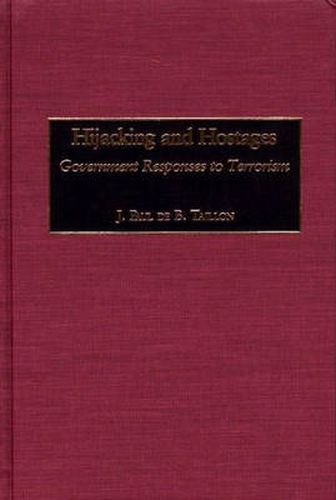Readings Newsletter
Become a Readings Member to make your shopping experience even easier.
Sign in or sign up for free!
You’re not far away from qualifying for FREE standard shipping within Australia
You’ve qualified for FREE standard shipping within Australia
The cart is loading…






Terrorism and its manifestations continue to evolve, becoming deadlier and more menacing. This study considers the evolution of terrorism since 1968 and how airlines and governments have attempted to deal with this form of violence through a series of nonforce strategies. Using historical examples, we see how governments, particularly the United States, attempted to counter politically motivated aerial hijacking with metal detectors, legal means, and, finally, in frustration, counterviolence operations to subdue terrorists. As nations witnessed aerial hijacking and sieges, the requirement for paramilitary and military counterterrorist forces became a necessity.
Through use of examples from Israel (Entebbe 1976), West Germany (Mogadishu 1977), and Egypt (Malta 1985), Taillon concludes that cooperation-ranging from shared intelligence to forward base access and observers-can provide significant advantages in dealing with low-intensity operations. He hopes to highlight those key aspects of cooperation at an international level which have, at least in part, been vital to successful counterterrorist operations in the past and, as we witnessed again in the campaign in Afghanistan, are destined to remain so in the future.
$9.00 standard shipping within Australia
FREE standard shipping within Australia for orders over $100.00
Express & International shipping calculated at checkout
Terrorism and its manifestations continue to evolve, becoming deadlier and more menacing. This study considers the evolution of terrorism since 1968 and how airlines and governments have attempted to deal with this form of violence through a series of nonforce strategies. Using historical examples, we see how governments, particularly the United States, attempted to counter politically motivated aerial hijacking with metal detectors, legal means, and, finally, in frustration, counterviolence operations to subdue terrorists. As nations witnessed aerial hijacking and sieges, the requirement for paramilitary and military counterterrorist forces became a necessity.
Through use of examples from Israel (Entebbe 1976), West Germany (Mogadishu 1977), and Egypt (Malta 1985), Taillon concludes that cooperation-ranging from shared intelligence to forward base access and observers-can provide significant advantages in dealing with low-intensity operations. He hopes to highlight those key aspects of cooperation at an international level which have, at least in part, been vital to successful counterterrorist operations in the past and, as we witnessed again in the campaign in Afghanistan, are destined to remain so in the future.